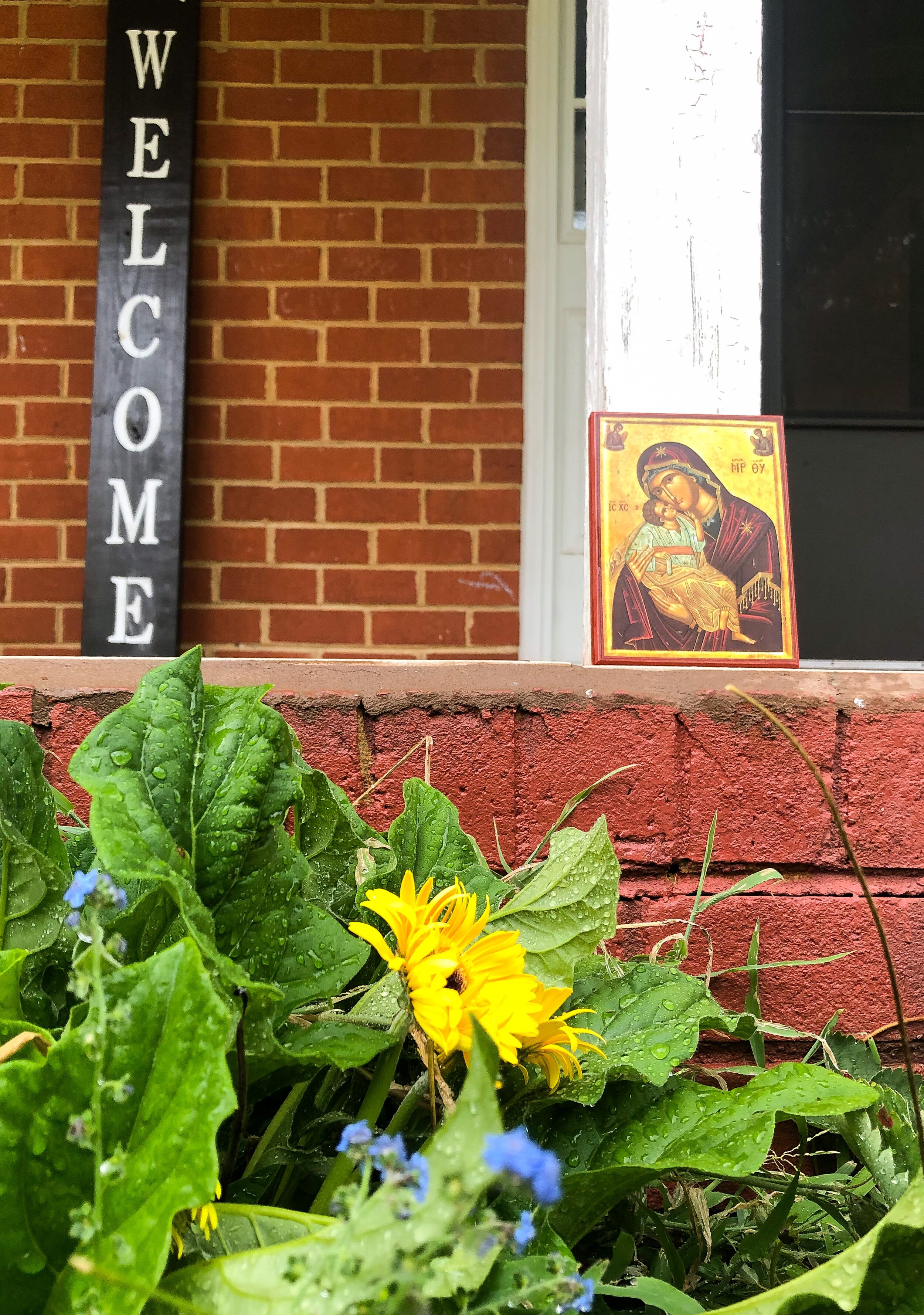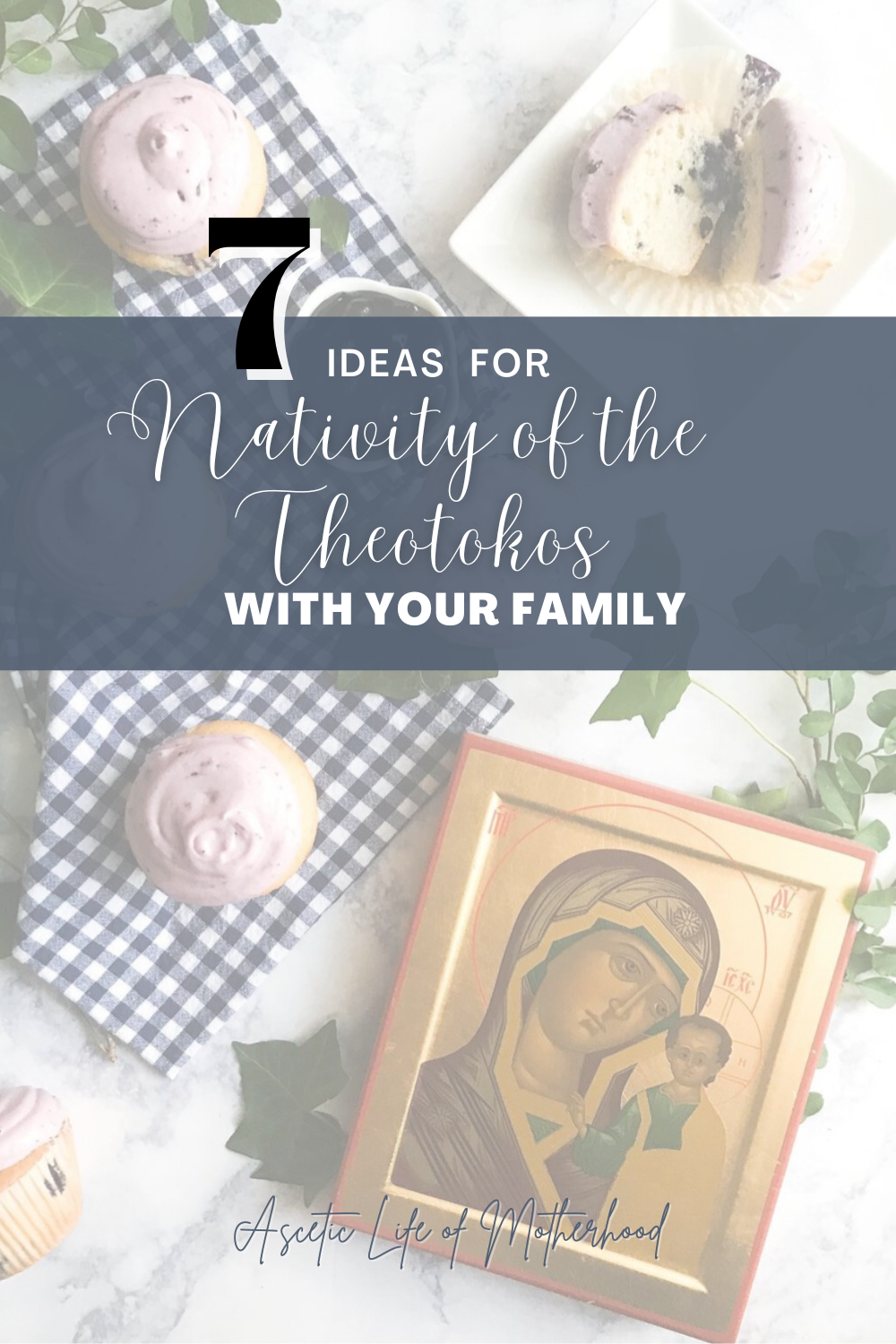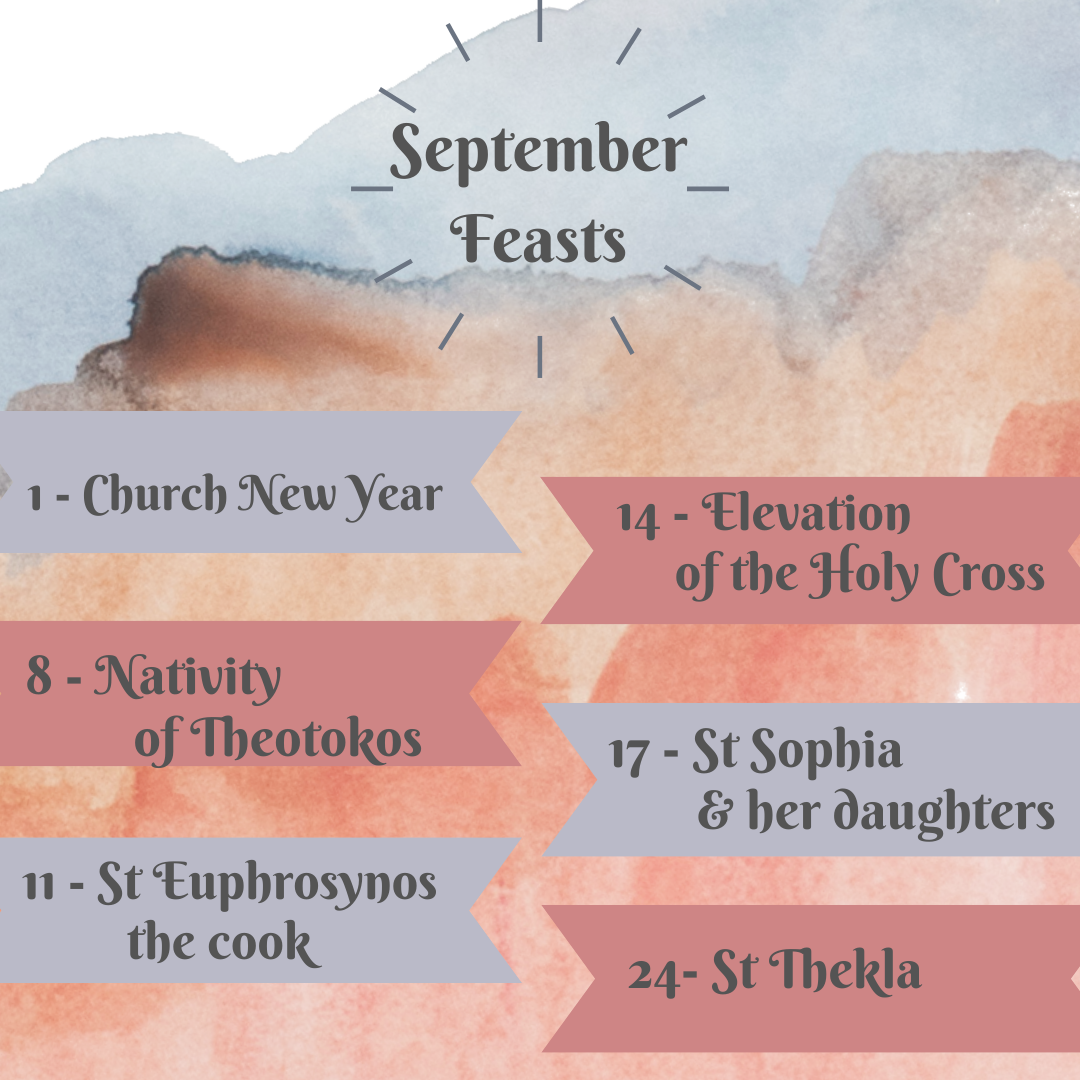September Liturgical Overview
September - In the Orthodox Church, the liturgical year begins on September 1st! I always take a big deep sigh at the chance to begin anew. Maybe it’s because the school year also begins in September, I feel inspired to re-organize, re-prioritize, and shift my focus towards living our lives oriented towards Christ. What a great opportunity! In addition to the New Church Year, we have some beloved saints celebrated this month + two Great Feast Days! We are planning some fun fall themed activities this month while also celebrating these wonderful saints. For example, I love incorporating apple themed treats or apple picking for St Euphrosynos’ feast day (September 11) since part of his story is the apples he received from paradise. I’m always searching for more ways to bring Christ into our home in a tangible, and meaningful way. Not every parent is a “crafty” person, so I’ve attempted to gather resources that can accommodate all types of interests (food, podcasts, crafts, coloring pages, etc) that can easily be put together with very little prep work or planning. If you’re reading this, you likely desire to bring Christ into your home as well. Thank God! Together, may we encourage one another to be who God created us to be, and help others along the way. I’m glad you are here! God bless your efforts and good strength as we strive for the Kingdom together.
Scroll down to see resources for the month in September!
Or check out these individual Blogposts:
Church New Year
Celebrated September 1
The first day of the Church New Year is September 1st. According to Holy Tradition, Christ entered the synagogue on September 1 to announce His mission to mankind (Luke 4:16-22). After reading this passage, Jesus announced to the assembly that this prophecy had been fulfilled in Him that day, right before their eyes, confirming His Messianic role. Although we cannot forensically confirm that date, it is spiritually significant that the Church has joined the first day of Jesus’ public ministry with the first day of the New Year in her rhythm of worship. Tradition also says that the Hebrews entered the Promised Land in September. Fascinating right? The Orthodox Church in many respects keeps the calendar of the Byzantine Empire. Under a system instigated by the Emperor St. Constantine the Great in the 4th century, the Indiction was a 15-year taxation cycle that began on September 1. Over time, this date came to be popularly observed throughout the Empire as the start of the New Year because it meant the beginning of a new period of taxation. The Church adopted this observance as well.
Activity Ideas:
Place an icon outside your home the eve of the New Church Year - As a way of ringing in the ‘new year’ and asking for Gods blessing over our homes in the upcoming new year. This is a simple village tradition and not a holy tradition. However, these “little t” traditions are important because they help us make Orthodoxy real for our children at home. It’s also said that in the morning, when you bring in the icon, it symbolized Christ being the first one to enter the house in the new year.
Plant a Tree - Each year as we begin the Church’s New Year on September 1st we are asked to consider the gift of Creation. While we were at seminary in New York, it was the tradition to plant a tree on the Church New Year. I hold this tradition fondly and love this idea for the New Year!
Create spiritual goals together as a family - At the Church New Year, we are once again invited to enter into the ancient rhythm of the Church. Now, everyone has heard of New Year’s resolutions, right? But, have you ever thought about setting spiritual goals with the new Church year? Check out this blogpost by Orthodox Motherhood on How to Create Spiritual Goals
Schedule Confession - As the New Year was approaching, I felt it necessary to schedule a confession with my Spiritual Father. It feels like the perfect time to begin anew with a clean heart!
Additional Ideas from Parousia Press:
Printable Festal Pennant Banner from Draw Near Designs
Print out feast day cards or a church calendar wheel so you have them to hand as each feast day approaches. Discuss the cycle of the liturgical year with your kids to set them up for the rhythm of what is coming.
Make a festal timeline or a festal "life cycle" chart. Start with the structure (names and dates) and add an icon to each entry as we move through the liturgical year.
Nativity of the Theotokos
Celebrated September 8th
The Nativity of the Theotokos is one of the 12 Great Feasts in the Orthodox Church, and in fact, it is the first major feast of the Liturgical Calendar. You’ve likely heard of the Nativity before, usually referring to the Birth of Jesus. But have you considered who Mary was before she was chosen to be the Mother of our Lord? The birth and early life of the Virgin Mary is not recorded in the Gospels or other books of the New Testament, however this information has been preserved through Holy Tradition throughout the Centuries. To see her early life, offers us a window into her centrality to the Christian Faith.
The story begins with her parents Joachim and Anna. They were descendants of the royal line of King David, they loved one another and tried to please God every day by following God’s commandments and trusting in Him. Their calm and peaceful life was overshadowed by one sorrow; God had not yet granted them a child, which was the desire of their heart. Throughout all the years of their married life, they prayed and asked God to make them parents. After so many years together, they were no longer of childbearing age and had accepted that they would remain childless. They never complained to God or were envious of others. God, seeing their faithfulness, granted them a great miracle - a child! Anna gave birth to Mary. They glorified God, and in gratitude for this miraculous gift, Joachim and Anna decided to dedicate their daughter to God. They raised her until she was 3 years old and then took her to the Temple in Jerusalem and placed her in the care of the high priest.
Activity Ideas:
Color a Line Drawing of the Icon of the Nativity of the Theotokos - We decided to paint our line drawing using watercolors. I love how they turned out and want to keep them forever!
Listen to a Song for Kids
“Feasts of Mary” By Gigi Baba Shadid - Listen to this song written for kids to help them learn more about Mary about her Feast Days throughout the year! It begins with the Nativity of the Mary (September 8th) and included are the various feast days surrounding Mary. Listen for free on YouTube here.
“Full of Grace”’ Also by Gigi Baba Shadid - written with kids in mind, this song is more solemn but a beautiful faith-filled song to the Theotokos. Listen for free on YouTube here.
“Celebrate the Feasts” by Gigi Baba Shadid - all about the 12 Major Feasts for the year. Songs are a wonderful way to help children memorize events and information. This is a great song to play/sing this week!
Listen to the book “The Story of Mary the Mother of God” (10 mins) by Dorrie Papademetriou read aloud in the podcast Readings from Under the Grapevine HERE
Image: IG @GeraldineandVirginia
Wear Blue to Liturgy - The Theotokos is often associated with the Liturgical color blue since ‘her womb was more spacious than the heavens!” Blue…heavens/sky…!
Bake a Birthday Cake or Cupcakes for the Theotokos - I always love a food connection when it comes to feast days. How do you celebrate birthdays? We usually have birthday cupcakes in our family! A fun way to help children remember this feast is by celebrating Mary’s “birthday” with cupcakes! Check out these beautiful cupcakes from @GeraldineandVirginia
Make a Card with the Icon of the Theotokos - Check out this thoughtful lesson and craft by Orthodox Pebbles (pictured below) about the Theotokos, which includes printables to create your own card for the Theotokos. You can find the FREE lesson plan and printables HERE.
Book Recommendations:
Maria: The Mother of God by New Rome Press - If you have not seen this book, I HIGHLY recommend it. First of all, the illustrations are beautiful… enough said! It tells the wondrous story of Maria, or Mary, who became the Mother of God - from her conception to her barren mother St. Anna, to her Falling Asleep. This amazing account of the Theotokos is told through story, hymnology, and captivating illustrations. Perfect for every feast day surrounding the Theotokos.
The Mother of God in Icons by Marina Paliaki - One of our favorites! I love the squishy yet sturdy cover, which makes it a very durable board book. It shared the story of Mary’s life, including events of our Lord like the crucifixion.
“The Story of Mary the Mother of God” by Dorrie Papademetriou. You can also listen to it read aloud in the podcast Readings from Under the Grapevine HERE
Heaven Meets Earth: Celebrating Pascha and the Twelve Great Feasts by Ancient Faith Publishing
Twelve Great Feasts for Children by Exaltation Press
St Euphrosynos the Cook
September 11th
St Euphrosynos - If you’ve ever noticed an icon in a kitchen, it’s likely an icon of St Euphrosynos, the cook saint, known to be holding a brand of apples! A friend helped me remember how to pronounce his name by telling me “You-froze-ya-nose” and that has stuck in my mind ever since! Now I can remember his name when I see his icon. He was a humble monastic whose desire was for anonymity. He is known for one incident in his life…
Story of Apples from Paradise As Euphrosynos fulfilled his monastic obedience in the kitchen as a cook for the brethren of the monastery. He continually dwelt in prayer and fasting. The brethren often reproached him, but he did not complain and endured every unpleasantness. St. Euphrosynos pleased the Lord by his inner virtue that he concealed from people, the spiritual heights of which their unassuming fellow-monk the Lord Himself revealed to the monastic brethren. One time, a priest of the monastery prayed asking the Lord to show him the blessings prepared for the righteous in the age to come. In a dream it seemed to the priest that he was standing in a garden. In it he also saw Euphrosynos, the cook of his monastery. Amazed at this encounter, the Priest asked Euphrosynos how he came to be there. The saint replied that he was in Paradise through the great mercy of God. The priest then asked if Euphrosynos would be able to give him something from the surrounding beauty. In reply, St. Euphrosynos suggested the priest take whatever he wished, and so the priest pointed to three luscious apples growing in the garden of Paradise. Euphrosynos picked the three apples, wrapped them in a kerchief and gave them to his companion.
When the priest awoke in the early morning, he initially thought the vision a dream, but suddenly he noticed next to him the cloth with the fruit of Paradise wrapped in it, emitting a wondrous fragrance. Later, the priest found St. Euphrosynos in church and asked him under oath where he was the night before. He replied that he was where the priest also was. Then, the monk continued that the Lord, in fulfilling the prayer of the priest, had shown him Paradise and had bestowed the fruit of Paradise through him, " the lowly and unworthy servant of God, Euphrosynos." Then, in an assembly of the monastery brethren, the priest related everything he had experienced, pointing out the spiritual heights of Euphrosynos in pleasing God and to the fragrant fruit of Paradise. Deeply impressed by what they heard, the monks went to the kitchen to pay respect to St. Euphrosynos. But, they did not find him there. Fleeing human glory, Euphrosynos had fled the monastery. The place where he concealed himself remained unknown, but the monks always remembered that their monastic brother St. Euphrosynos had come upon Paradise, and that they, in being saved through the mercy of God, would meet him there. The pieces of the apples from Paradise, the brethren reverently kept and distributed for blessing and for healing.
Image by Orthodox Mom
Activity Ideas :
Make an Apple Dessert - St Euphrosynos brought back fruit from paradise, which is often depicted as apples in iconography. Consider making an apple dessert! My friend, Orthodox Mom, shared a yummy apple dessert on her blog, which you can check out HERE. We plan to make an apple crisp with ice cream on top! But other ideas include apple sauce, apple slaw salad, and apple pie. The possibilities are endless!
Go Apple Picking - When we were living in New York, the apple picking season was in the beginning of September, which lined up perfectly with St Euphrosynos feast day, so we always scheduled our apple picking then. There’s something extra fun about reading the story of his life and picking “apples from paradise”. This is a perfect time to be reminded of God’s goodness to us, and the abundance of the fruits of the earth!
Place an Icon of St Euphrosynos in Your Kitchen - Many Orthodox Christians have the icon of St. Euphrosynos the Cook somewhere in their kitchen. On a list of “must have” icons, I put this up there near the top of the list (along with the Christ and the Theotokos, The Last Supper - typically near the place you eat, Hospitality of Abraham, etc). I ask his intercessions often when I’m baking something new or to bless our food. You can find his icon through many Online Orthodox Icon stores.
Listen to the book “The Boy, A Kitchen and His Cave” (part 1 - 17 mins) by Catherine K. Contopoulos read aloud in the podcast Readings from Under the Grapevine. Part 1 HERE and Part 2 HERE
Photo by Charlotte Riggle
Book Recommendations:
The Boy, A Kitchen, and His Cave - A clumsy scullery boy finds solace in a place known only to him and his God in this charming children’s book about St Euphrosynos, commonly known in Orthodox tradition as "The Cook." Written for ages 6-10. You can also listen to it read aloud in the podcast Readings from Under the Grapevine Part 1 HERE and Part 2 HERE.
Source: https://www.goarch.org/exaltation
Elevation of the Holy Cross
Celebrated September 14th
The Feast of the Elevation of the Holy Cross is celebrated each year on September 14. The Feast commemorates the finding of the True Cross of our Lord and Savior Jesus Christ by Saint Helen in 326, the mother of the Emperor Constantine. It is also the celebration of the return of the Cross from Persia to Jerusalem in the year 628.
Activities:
Paper Puppets and Lesson on the Discovery of the Holy Cross by Orthodox Pebbles - In this FREE download, you will find printable paper puppets to recreate the story of the discovery of the Holy Cross HERE
Decorate/Adorn The Cross - Why not take the story of St Helen’s discovery of the cross and beautify and adorn your own cross! You can create a wooden cross using two wooden craft sticks glued together in the shape of a cross or a store bought wooden cross (places like Michael’s, Hobby Lobby or the Dollar Tree have these in the craft section). Decorate it using colored tissue paper or markers or whatever else you have on hand. You could even put real flowers and basil on top as well, and display it on your home altar to remind you of the life-giving cross!
Bury and Discover the True Cross - Using 3 wooden crosses you create out of craft sticks, find a place in your yard or garden to dig and hide 3 crosses! I gave my kids the crosses to bury a few days before the feast. Then after you tell them the story, give your kids shovels or using their hands, send them out to dig up and find the crosses! Make it extra fun by adding a marking on the “true cross” so they can recreate the discovery of the cross (even using the printable paper puppets fro the Orthodox pebbles materials (linked above and HERE).
Coloring Page By Draw Near Designs, featured in the Royal Saints Coloring Book
Searching for the Cross Sensory Bin (featured in October 2020 Orthodox Children’s Calendar)
NEED: 1 Gallon sized plastic bag
3 Cups rice
10-20 drops of green food coloring
1 TBSP vingar
Fresh Basil
3 crosses (any crosses you have - or make out of craft sticks)
Baking dish and baking tray
DIRECTIONS Pour rice, food coloring (10-20 drops of green), and vinegar into a gallon sized plastic bag. Seal tightly and have your kids shake, squeeze, and toss the bag for a few minutes until the rice is evenly coated with the food coloring and looks like your desired color. Then pour rice onto a cookie tray and leave it to dry for at least an hour. You can store it in a plastic bag for later. Once dry, place it in a 9X13 dish with the basil and bury 3 crosses (any crosses you have - or make out of craft sticks) under the rice and basil. Have your kids dig down like Saint Helen did to find the crosses. They can also take turns finding the crosses!
Listen to the Song “Finding the Cross” by Gigi Baba Shadid in this fun song meant for children, you can learn more about the discovery of the Holy Cross by St Helen in a way that is fun and engaging for young children! It’s catchy and easy for kids to remember and sing along!
Book Recommendations:
Saint Constantine the Great “In This Conquer” Paterikon for Kids Series book by Potamitis Publishing
Saint Helen and the Finding of the Holy Cross Paterikon for Kids Series book by Potamitis Publishing
My Warrior Saints (Hardcover) (St Constantine on page 43) By Potamitis Publishing
Heaven Meets Earth : Celebrating Pascha and the Twelve Feasts (Elevation of the Cross page 10) by Ancient Faith Publishing (also Available on Amazon)
The Great Feasts by Exaltation Press (Exaltation of the Holy Cross page 30)
Check out these Book Recommendations for September
September Synaxarion by Potamitis Publishing
September My Synaxarion, A Saint for Every Day is a brand new series of books, with each book covering the Saints' lives commemorated each month. This book is 92 pages, hardcover bound and a perfect addition to any library! ]You can purchase it HERE.































